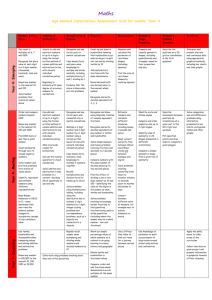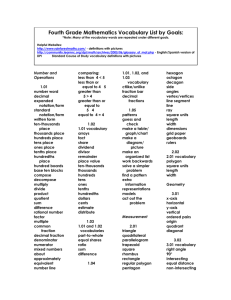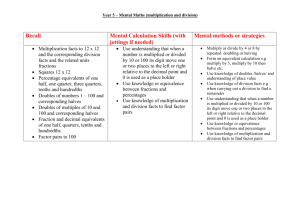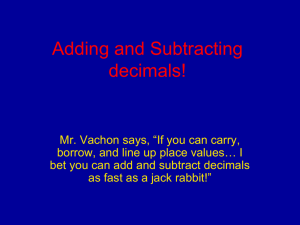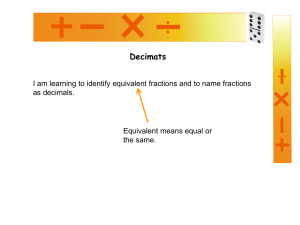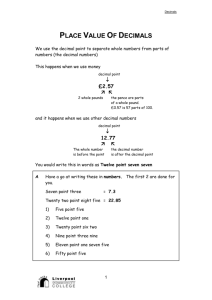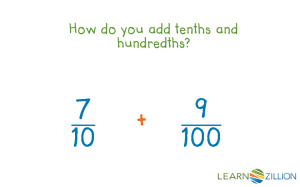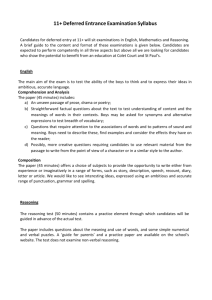Cycle 1 Math Rubrics – To Competency 2 – To Reason using
advertisement
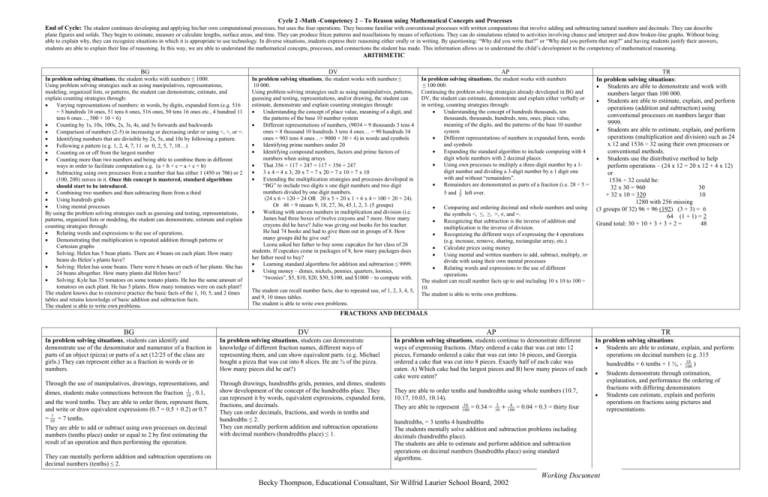
Cycle 2 -Math -Competency 2 – To Reason using Mathematical Concepts and Processes End of Cycle: The student continues developing and applying his/her own computational processes, but uses the four operations. They become familiar with conventional processes with written computations that involve adding and subtracting natural numbers and decimals. They can describe plane figures and solids. They begin to estimate, measure or calculate lengths, surface areas, and time. They can produce frieze patterns and tessellations by means of reflections. They can do simulations related to activities involving chance and interpret and draw broken-line graphs. Without being able to explain why, they can recognize situations in which it is appropriate to use technology. In diverse situations, students express their reasoning either orally or in writing. By questioning: “Why did you write that?” or “Why did you perform that step?” and having students justify their answers, students are able to explain their line of reasoning. In this way, we are able to understand the mathematical concepts, processes, and connections the student has made. This information allows us to understand the child’s development in the competency of mathematical reasoning. ARITHMETIC BG DV AP In problem solving situations, the student works with numbers ≤ 1000. Using problem solving strategies such as using manipulatives, representations, modeling, organized lists, or patterns, the student can demonstrate, estimate, and explain counting strategies through: Varying representations of numbers: in words, by digits, expanded form (e.g. 516 = 5 hundreds 16 ones, 51 tens 6 ones, 516 ones, 50 tens 16 ones etc., 4 hundred 11 tens 6 ones…, 500 + 10 + 6) Counting by 1s, 10s, 100s, 2s, 3s, 4s, and 5s forwards and backwards Comparison of numbers (2-5) in increasing or decreasing order or using <, >, or =. Identifying numbers that are divisible by 2s, 5s, and 10s by following a pattern. Following a pattern (e.g. 1, 2, 4, 7, 11. or 0, 2, 5, 7, 10…) Counting on or off from the largest number Counting more than two numbers and being able to combine them in different ways in order to facilitate computation e.g. (a + b + c = a + c + b) Subtracting using own processes from a number that has either 1 (450 or 706) or 2 (100, 200) zeroes in it. Once this concept is mastered, standard algorithms should start to be introduced. Combining two numbers and then subtracting them from a third Using hundreds grids Using mental processes By using the problem solving strategies such as guessing and testing, representations, patterns, organized lists or modeling, the student can demonstrate, estimate and explain counting strategies through: Relating words and expressions to the use of operations. Demonstrating that multiplication is repeated addition through patterns or Cartesian graphs Solving: Helen has 5 bean plants. There are 4 beans on each plant. How many beans do Helen’s plants have? Solving: Helen has some beans. There were 6 beans on each of her plants. She has 24 beans altogether. How many plants did Helen have? Solving: Kyle has 35 tomatoes on some tomato plants. He has the same amount of tomatoes on each plant. He has 5 plants. How many tomatoes were on each plant? The student knows due to extensive practice the basic facts of the 1, 10, 5, and 2 times tables and retains knowledge of basic addition and subtraction facts. The student is able to write own problems. In problem solving situations, the student works with numbers ≤ 10 000. Using problem solving strategies such as using manipulatives, patterns, guessing and testing, representations, and/or drawing, the student can estimate, demonstrate and explain counting strategies through: Understanding the concept of place value, meaning of a digit, and the patterns of the base 10 number system Different representations of numbers, (9034 = 9 thousands 3 tens 4 ones = 8 thousand 10 hundreds 3 tens 4 ones… = 90 hundreds 34 ones = 903 tens 4 ones…= 9000 + 30 + 4) in words and symbols Identifying prime numbers under 20 Identifying compound numbers, factors and prime factors of numbers when using arrays. That 356 + 117 + 247 = 117 + 356 + 247 3 x 4 = 4 x 3; 20 x 7 = 7 x 20 = 7 x 10 + 7 x 10 Extending the multiplication strategies and processes developed in “BG” to include two digits x one digit numbers and two digit numbers divided by one digit numbers. (24 x 6 = 120 + 24 OR 20 x 5 + 20 x 1 + 6 x 4 = 100 + 20 + 24). Or 48 ÷ 9 means 9, 18, 27, 36, 45.1, 2, 3. (5 groups) Working with uneven numbers in multiplication and division (i.e. James had three boxes of twelve crayons and 7 more. How many crayons did he have? Julio was giving out books for his teacher. He had 74 books and had to give them out in groups of 8. How many groups did he give out? Leona asked her father to buy some cupcakes for her class of 26 students. If cupcakes come in packages of 8, how many packages does her father need to buy? Learning standard algorithms for addition and subtraction ≤ 9999. Using money – dimes, nickels, pennies, quarters, loonies, “twonies”, $5, $10, $20, $50, $100, and $1000 – to compute with. In problem solving situations, the student works with numbers ≤ 100 000. Continuing the problem solving strategies already developed in BG and DV, the student can estimate, demonstrate and explain either verbally or in writing, counting strategies through: Understanding the concept of hundreds thousands, ten thousands, thousands, hundreds, tens, ones, place value, meaning of the digits, and the patterns of the base 10 number system Different representations of numbers in expanded form, words and symbols Expanding the standard algorithm to include computing with 4 digit whole numbers with 2 decimal places. Using own processes to multiply a three-digit number by a 1digit number and dividing a 3-digit number by a 1 digit one with and without “remainders”. Remainders are demonstrated as parts of a fraction (i.e. 28 ÷ 5 = 5 and 53 left over. The student can recall number facts, due to repeated use, of 1, 2, 3, 4, 5, and 9, 10 times tables. The student is able to write own problems. Comparing and ordering decimal and whole numbers and using the symbols <, ≤, ≥, >, ≠, and =. Recognizing that subtraction is the inverse of addition and multiplication is the inverse of division. Recognizing the different ways of expressing the 4 operations (e.g. increase, remove, sharing, rectangular array, etc.) Calculate prices using money Using mental and written numbers to add, subtract, multiply, or divide with using their own mental processes Relating words and expressions to the use of different operations The student can recall number facts up to and including 10 x 10 to 100 ÷ 10. The student is able to write own problems. TR In problem solving situations: Students are able to demonstrate and work with numbers larger than 100 000. Students are able to estimate, explain, and perform operations (addition and subtraction) using conventional processes on numbers larger than 9999. Students are able to estimate, explain, and perform operations (multiplication and division) such as 24 x 12 and 1536 ÷ 32 using their own processes or conventional methods. Students use the distributive method to help perform operations – (24 x 12 = 20 x 12 + 4 x 12) or 1536 ÷ 32 could be: 32 x 30 = 960 30 + 32 x 10 = 320 10 1280 with 256 missing (3 groups 0f 32) 96 + 96 (192) (3 + 3) = 6 64 (1 + 1) = 2 Grand total: 30 + 10 + 3 + 3 + 2 = 48 FRACTIONS AND DECIMALS BG DV In problem solving situations, students can identify and demonstrate use of the denominator and numerator of a fraction in parts of an object (pizza) or parts of a set (12/25 of the class are girls.) They can represent either as a fraction in words or in numbers. In problem solving situations, students can demonstrate knowledge of different fraction names, different ways of representing them, and can show equivalent parts. (e.g. Michael bought a pizza that was cut into 8 slices. He ate ¾ of the pizza. How many pieces did he eat?) Through the use of manipulatives, drawings, representations, and 1 dimes, students make connections between the fraction 10 , 0.1, Through drawings, hundredths grids, pennies, and dimes, students show development of the concept of the hundredths place. They can represent it by words, equivalent expressions, expanded form, fractions, and decimals. They can order decimals, fractions, and words in tenths and hundredths ≤ 2. They can mentally perform addition and subtraction operations with decimal numbers (hundredths place) ≤ 1. and the word tenths. They are able to order them, represent them, and write or draw equivalent expressions (0.7 = 0.5 + 0.2) or 0.7 7 = 10 = 7 tenths. They are able to add or subtract using own processes on decimal numbers (tenths place) under or equal to 2 by first estimating the result of an operation and then performing the operation. They can mentally perform addition and subtraction operations on decimal numbers (tenths) ≤ 2. AP TR In problem solving situations, students continue to demonstrate different ways of expressing fractions. (Mary ordered a cake that was cut into 12 pieces, Fernando ordered a cake that was cut into 16 pieces, and Georgia ordered a cake that was cut into 8 pieces. Exactly half of each cake was eaten. A) Which cake had the largest pieces and B) how many pieces of each cake were eaten? In problem solving situations: Students are able to estimate, explain, and perform operations on decimal numbers (e.g. 315 18 hundredths + 6 tenths + 1 ½, - 100 ) They are able to order tenths and hundredths using whole numbers (10.7, 10.17, 10.03, 10.14). 3 34 4 100 They are able to represent 100 = 0.34 = 10 = 0.04 + 0.3 = thirty four hundredths, = 3 tenths 4 hundredths The students mentally solve addition and subtraction problems including decimals (hundredths place). The students are able to estimate and perform addition and subtraction operations on decimal numbers (hundredths place) using standard algorithms. Working Document Becky Thompson, Educational Consultant, Sir Wilfrid Laurier School Board, 2002 Students demonstrate through estimation, explanation, and performance the ordering of fractions with differing denominators Students can estimate, explain and perform operations on fractions using pictures and representations. Cycle 2 – Math – Competency 2 Cont’d) BG In problem solving situations, students describe pyramids and prisms (including pentagon, hexagon, and octagon) according to their vertices, faces, and edges. They continue to classify them according to their attributes and make connections between the similar patterns of their composition. (Pyramids have some triangular faces, prisms, except cubes, have some rectangular faces, or Prisms have 3x the amount of edges than that of the its identifying plane figure i.e. a square has 4 sides, a cube or rectangular prism has 12 edges (4 x 3)). Students can construct and/or identify prisms and pyramids using nets. They can differentiate between similar and congruent shapes and figures. GEOMETRY DV AP In problem solving situations, students can place or locate a point or a figure on the positive quadrant of a Cartesian graph or a plane. In problem solving situations and through the use of drawings and words, students can describe convex and non-convex ( ) polygons. They can produce more advanced frieze and tessellation patterns and describe or use a reflection line. They can demonstrate knowledge that (e.g.) a hexagon is made up of 6 triangles, or two triangles can make a rectangle.) Through the use of parallel, perpendicular, congruent, and/or non-congruent lines, and right, acute, and/or obtuse angles students construct, observe, describe, compare and classify quadrilaterals which include trapezoids, parallelograms, squares, rectangles, and rhombi. Using reflections a student can produce and/or describe frieze patterns. ▪►▪▪◄▪▪►▪▪◄ ▪ Using reflections, students can produce and/or describe tessellations Using geometric solids and polygons, students can produce and observe patterns. (e.g. ▲◊∆◊▪◊▫◊▲◊…) TR In problem solving situations, students can produce tessellations through the use of translations (slides). They examine, identify, describe, classify, and construct triangles using the words congruent, acute, and obtuse. They can’t name, but notice and are able to classify, triangles that are equilateral, isosceles, and scalene. Within different polygons, they identify different shapes that could be used to construct them and the fractional parts they occupy. MEASUREMENT BG In problem solving situations, students begin estimating and then measuring with conventional units of measurement (cm, m) and time (h, min). They expand their understanding of daily, weekly, monthly, and yearly cycles through the use of bar graphs, calendars, rudimentary schedules and time lines. They solve problems such as: Rejean took a walk around the block. He found out that he could walk 500 metres in 10 minutes. If he walked at the same speed for 30 minutes, how far would he go? Laura had to cut a ribbon into 3 parts. If each part was 20 cm long, how long was the ribbon to begin with? Arianna walked 80 m in 10 minutes. How far could she walk in 5 minutes at the same speed? Ted had to divide his paper into four equal parts. If the paper was 32 cm long, how big was each part? DV AP In problem solving situations and building on the strategies developed in “BG”, students expand their understanding of the metric system by measuring in mm, cm, dm, and m. Through regular exposure and practice, they begin to be able to explain appropriate situations when each of these units should be used. TR In problem solving situations, students estimate, measure, or calculate lengths (including perimeter) using conventional units. They use the most appropriate unit of measurement when measuring a length. They are able to demonstrate the relationship between mm, cm, dm, and m. In conjunction with developing multiplication strategies, students begin measuring surface areas through the use of arrays and unconventional units. They experiment with different representations of the same “area”. (E.g.. 12 can be 1 x 12, 2 x 6, or 3 x 4). They demonstrate an understanding of perimeter using unconventional units. Students estimate, measure, or calculate areas and volumes using unconventional units of measurement. As a natural extension of comparing quadrilaterals, the student demonstrates, compares and explains the differences between right, acute, and obtuse angles. Students increase their understanding of time to include seconds. PROBABILITY AND STASTITICS BG DV The students formulate survey questions that involving a yes, no, or maybe answer. They collect, display, and organize their data and, based on their findings, come to simple conclusions. The students simulate simple probability experiments. They gather data and make observations (e.g. in tossing a die 20 times, the number 6 came up 3 times). They display this data using a pictograph, bar graph, or table. The students interpret the results obtained from a study using a broken-line graph. Students expand survey questions to include a wider choice of responses (What is your favourite breakfast food?) They collect, organize, and display their data and make simple conclusions that use the words more, less, or just as likely. Students demonstrate an understanding of chance by using such terms as equally probable and less probable. They represent the data for a study using a broken-line graph. CULTURAL REFERENCES *One of AP TR Students enumerate the possible results of a probability experiment using simulations (e.g. tossing two coins: HH, HT, TH, TT). They gather data (questionnaire, measuring instrument, documentation) and organize them into a table. They represent the data with the help of diagrams and interpret the results. these topics must be covered per cycle. * Calculator keys: 0 to 9, +, -, x, ÷, ON, OFF, C, AC, CE Origin and creation of number systems (e.g. Arabic, Babylonian, Roman, Mayan) characteristics, advantages, disadvantages Social context (date, price, telephone, address, age, quantity, mass, size) Origin of the symbols, their need, development, and mathematicians involved of +, -, >, <, =, x, ÷, ∞ (infinity), , , //, Origin, development of technology (sticks, strokes, abacus, calculator, software) limitations, advantages, and disadvantages Social context of maps Historical aspects of systems of measurement Origin of units of measurements, development according to society’s need of instruments (hourglass, clock), m, dm, cm, mm Origin, development, need of h, min, s (Writing time 2:10, 2 h 10 min) Becky Thompson, Educational Consultant Sir Wilfrid Laurier School Board, 2002 Working Copy Numbers written using digits Writing fractions Writing decimals using a period as a decimal marker) $, ¢


